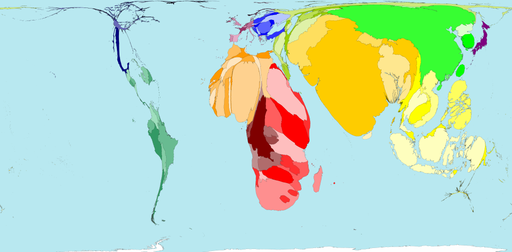In 2003 tuberculosis, also mentioned as 'TB', affected 8.7 million people, but another statistic from 2007 mentions 13.7 million chronic active cases and 9.3 million new cases. Most of these people lived in Asia and Africa, a small proportion were in Europe and the Americas.
The World Health Organisation reports that someone with open tuberculosis would infect 10 to 15 people a year. So when a certain number of people are infected it is very hard to stop it spreading further.
Tuberculosis is caused by various strains of mycobacteria, usually Mycobacterium tuberculosis in humans. Tuberculosis usually attacks the lungs but can also affect other parts of the body. It is spread through the air, when people who have the disease cough, sneeze, or spit. Most infections in humans result in an asymptomatic, latent infection, and about one in ten latent infections eventually progresses to active disease, which, if left untreated, kills more than 50% of its victims.
The classic symptoms are a chronic cough with blood-tinged sputum, fever, night sweats, and weight loss. Infection of other organs causes a wide range of symptoms. Diagnosis relies on radiology (commonly chest X-rays), a tuberculin skin test, blood tests, as well as microscopic examination and microbiological culture of bodily fluids.
Medical treatment of tuberculosis is difficult and requires long courses of multiple antibiotics. Antibiotic resistance is a growing problem in multi-drug-resistant tuberculosis. Prevention relies on screening programs and vaccination, usually with Bacillus Calmette-Guérin vaccine.
The proportion of people who become sick with tuberculosis each year is stable or falling worldwide but, because of population growth, the absolute number of new cases is still increasing. In 2007 there were an estimated 1.8 million deaths, mostly in developing countries. In addition, more people in the developed world are contracting tuberculosis because their immune systems are compromised by immunosuppressive drugs, substance abuse, or AIDS. The distribution of tuberculosis is not uniform across the Globe; about 80% of the population in many Asian and African countries test positive in tuberculin tests, while only 5−10% of the US population test positive.
The highest tuberculosis cases in 2003 in Earth in shown in the table below: cases per 100,000 persons.
Rank | Territory | cases/100,000 |
1 | Swaziland | 1083 |
2 | Djibouti | 735 |
3 | Lesotho | 733 |
4 | Namibia | 722 |
5 | Zimbabwe | 659 |
6 | Zambia | 656 |
7 | Botswana | 633 |
8 | Kenya | 610 |
9 | Timor-Leste | 556 |
10 | South Africa | 536 |
http://www.worldmapper.org/posters/worldmapper_map228_ver5.pdf
http://en.wikipedia.org/wiki/Tuberculin
